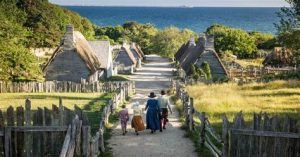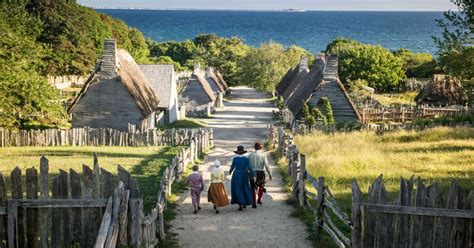November of 1621 marked one-year in the New World for a band of what began as 35 English religious separatists and 67 entrepreneurs who had landed on the shores of New England. In their first winter, harsh conditions and diseases like pneumonia and scurvy led to the death of forty-five of the original 102.
In keeping with an almost fifty-year-old English tradition, the remaining settlers along with some Wampanoag Indian tribe members came together for the first Thanksgiving feast. But rather than the bounty that we often see depicted in pictures, the situation for the English colonists was actually quite dire.

According to William Bradford, the Governor of Plymouth for its first thirty years and author “Of Plymouth Plantation,” prior to sailing for the New World, the Pilgrims and the entrepreneurs signed a seven year contract stipulating that, “all profits and benefits that are got by trade, traffic, trucking, working, fishing, or any other means of any person or persons” shall be pooled for the common benefit.
That’s right, the Pilgrims started off trying to establish a socialist society where “at the end of the seven years, the capital and profits, the houses, lands, goods and chattels, be equally divided betwixt the ‘Adventurers’ and Planters..”
Food, drink, apparel and other provisions were provided out of the common stock and goods of the colony, meaning quite simply that those who worked hard got the same provisions as those who loafed.The first two-years were a disaster with shortages and starvation as the youngest and strongest men complained that they had to work for other men’s wives and family without pay. Needless to say, the lack of incentive to thrive caused additional privation, so while the first Thanksgiving in America likely was held on a day in late November in 1621 to celebrate the blessings that God had provided, Bradford makes it clear that there was not abundance, but instead there was a food shortage.
After two-years, the Pilgrims decided that a change was needed, so they decided to end the common goods experiment by giving every family a plot of land based upon their size, establishing private property rights in the colony.
Governor Bradford proclaimed the change to have created, “…very good success, for it made all hands very industrious, so as much more corn was planted than otherwise would have been…”
“The women now went willingly into the field, and took their little ones with them to set corn; which before would allege weakness and inability; whom to have compelled would have been thought great tyranny and oppression.’
The Pilgrims no longer resented going into the field because they got to keep the benefits of their labor. Bradford reports, “Instead of famine now God gave them plenty,” and that, “… the face of things was changed, to the rejoicing of the hearts of many, for which they blessed God…. Any general want or famine hath not been amongst them since to this day.”
Yes, the early days of the Plymouth colony proved that even amongst a very small, interdependent group, the socialist model is a failure. Not just an academic exercise that went awry, but instead a mistake that cost many of the original settlers their lives.
And the picture of abundance that is associated with the first Thanksgiving is more appropriately assigned to the third one, when corn was plentiful and the people could look forward to a long winter with sufficient provisions produced through their own labor.
If American schools still taught American history to our children, teenagers and college students, every single one would recognize that Karl Marx’ socialist ideal almost killed the Pilgrim colony and it was only through private ownership of property and the ability to profit off of that property through your own hard labor that a true Thanksgiving feast was established.
Having visited Plymouth for the 399th anniversary of the Pilgrim’s landing on what is now the shores of Massachusetts, it is hard not to be struck by how this simple message is obscured in official presentations and pomp.
The bounty was from free enterprise and private property ownership, and the Thanksgiving was to God, who makes all things possible and was the founder of their feast. While death was rampant and the future of a hard winter of near starvation was nearly upon them, the Pilgrims celebrated with their new neighbors because while the previous year had been cataclysmic, the hope for a reconciliation with God through Jesus was reason enough to celebrate.
This Thanksgiving as we gather around with family either in person or virtually, remember back to that real first Thanksgiving where the people celebrated blessings from God during a time which was far more bleak than our current COVID crisis shutdowns.
And that is the real story of the first couple of Thanksgivings, so when sitting around the table or in front of a computer screen, remind everyone that while showing gratitude to your friends and others is a good thing, the real focus of Thanksgiving should be to our Father in heaven, the creator of all things.
Happy Thanksgiving!
Rick Manning is President of Americans for Limited Government.
To view online: https://dailytorch.com/2022/11/from-privation-to-private-property-the-true-story-of-thanksgiving/
